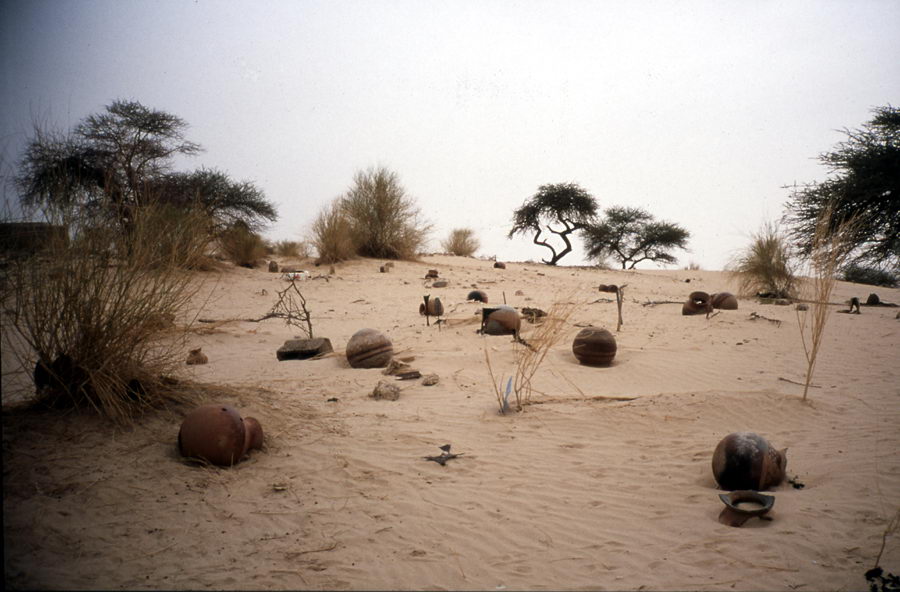Cemetery #1
2002 - Photography (Photography)
40,6 x 50,8 cm
Gabriel Orozco
Gabriel Orozco comments: “In the exhibition [Documenta 11, Kassel, 2002], I tried to connect with the photographs I took in Mali in July. I traveled to Mali for three weeks and took some photographs related to my work. They are very different, but there are links as the graveyard of Timbuktu, which I discovered during the trip. I found the cemetery because I was interested in pottery and ceramics. Research traditions of ceramics were the reason for my trip to Africa in Mali, to understand, learn, appreciate what they did, because it is an important tradition in Mali. And then I discovered the cemetery in Timbuktu. It is interesting to see how the work will take you to discover places you would never have discovered if you did not work. So the link between what you do and what you find in a second time is very interesting. In this context, the exhibition presents one hand tables with ceramics. In addition, photographs of Mali are on the walls. There is no direct link. But it is obvious that the same person who is interested in these things. And there are many reasons for this.
Gabriel Orozco could be described as a traveler-artist, without a fixed studio. He works following contexts and produces work that flows. “Special Service” (1997) is a collage on a plane ticket, and indicates nomadism, between territories. The artist, who is the son of muralist Mario Orozco Riviera, questions the boundaries of his artistic identity in Mexico. In “Crazy tourist” (1991), Orozco creates a situation with oranges in the Brazilian market tables in a desert. The artist uses objects or “poor” situations, found in the everyday landscape, natural or urban. By their division, their juxtaposition, or collage, inventing semantic or sensitive scenarios, always surprising, sometimes humorous and sometimes lyrical … The sculptural practice of the artist, inseparable from his drawings, photographs, or films, invents relationships of space, and disrupts our perception of objects. Such is the case of “Yielding Stone” (1992), a photo of a plasticine ball, the weight of the artist, rolled through the streets of New York. Gabriel Orozco was born in 1962 in Jalapa, Mexico. He lives and works in New York, Mexico, and Paris.
Colors:
Other related works, blended automatically

© » KADIST
Gabriel Orozco
1992Gabriel Orozco often documents found situations in the natural or urban landscape...

© » KADIST
Yoshua Okón
2009Canned Laughter was Okón’s response to an invitation from Ciudad Juárez , Mexico, where artists were asked to create works based on their experience of the city...

© » KADIST
Abraham Cruzvillegas
2004Wright Imperial Hotel (2004) is a sort of bow and arrow made out of feathers, a São Paulo phone book, and other materials...

© » KADIST
Douglas Gordon
2004Douglas Gordon’s single-channel video The Left Hand Can’t See That The Right Hand is Blind, captures an unfolding scene between two hands in leather gloves—at first seemingly comfortable to be entwined, and later, engaged in a struggle...

© » KADIST
Julio Cesar Morales
2008The video Interrupted Passage presents a performance Morales staged in the former home of Mariano Guadalupe Vallejo, a mid-nineteenth-century Mexican general serving in California...

© » KADIST
Mungo Thomson
2010In Thomson’s Untitled (TIME) , every front cover of TIME magazine is sequentially projected to scale at thirty frames per second...

© » KADIST
Jennifer Bornstein
1994Collectors’ Favorites is an episode of local cable program from the mid-1990s in which ordinary people were invited to present their personal collections—a concept that in many ways anticipates current reality TV shows and internet videos...

© » KADIST
Yee I-Lann
20207-headed Lalandau Hat by Yee I-Lann is an intricately woven sculpture evoking the ceremonial headdress worn by Murut men in Borneo...

© » KADIST
Pedro Reyes
2005In Reyes’s words, “We should be able to extract the technological nutrients before we excrete our waste...

© » KADIST
Mungo Thomson
2014Starting with Bruce Nauman’s iconic artwork, The True Artist Helps the World by Revealing Mystic Truths (Window or Wall Sign) , Mungo Thomson’s neon sign is one of a series that replaces Nauman’s quixotic mini-manifesto with aphorisms from ‘recovery’ culture, especially those made popular by alcoholics anonymous...

© » KADIST
Piero Golia
2007Golia’s Untitled 3 is an installation in which a mechanical device is programmed to shoot clay pigeons that are thrown up in front of a white wall...

© » KADIST
Pablo Rasgado
2011Pablo Rasgado’s paintings and installations serve as a visual record of contemporary urban human behavior...

© » KADIST
Oded Hirsch
2012Oded Hirsch’s video work Nothing New (2012) utilizes seemingly absurdist tropes to raise more trenchant questions about communal action and collective identity in modern day Israel...

© » KADIST
Mario Garcia Torres
Mario Garcia Torres discovered the work of artist Oscar Neuestern in an article published in ARTnews in 1969...

© » KADIST
Yang Zhenzhong
2012Peasant Sensation Passing Through Flesh – 3 consists of a massage chair fixed to a wall...

© » KADIST
Julio Cesar Morales
2006Julio Cesar Morales’s watercolor drawings, Undocumented Intervention , show a variety of surprising hiding places assumed by people trying to cross into the United States without documentation...




